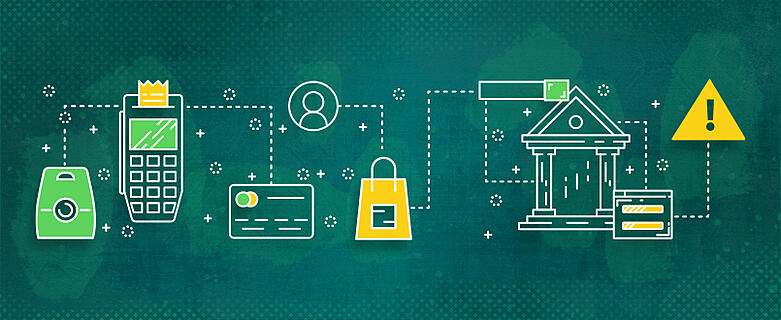News

Stop Chargebacks: Best Practices for Merchants at Each Risk Level
Every business that accepts credit card payments needs to have a strategy for stopping chargebacks. They’re costly, dangerous to the health of your merchant accounts (MIDs), and many of them are friendly fraud or otherwise preventable. However, the impact of chargebacks can vary significantly between merchants. Payment processors and card networks place merchants into low, medium, and high-risk categories for chargebacks.
This classification is based on the industry, e-commerce or brick and mortar and other factors. The categories matter because they determine the cost of the chargeback fees charged to the merchant and their chargeback threshold: their maximum allowable ratio of chargebacks to transactions.
When you’re figuring out your chargeback prevention strategy, knowing your risk classification matters. Chargebacks happen for all kinds of reasons, and the impact on small, low-risk merchants is quite different from high volume, high-risk merchants.
Either way, you need a strategy that fits your business model. Chargebacks are very damaging to a merchant’s bottom line because they can cost up to three times the transaction amount. There are also genuine dangers of losing your MID if you exceed your chargeback threshold, forcing you to open MIDs with more expensive payment processors. If your chargeback rate continues to exceed 1%, the card networks can place you on their blacklist for up to five years.
For merchants in each category—low, medium, and high-risk—there are appropriate and reliable best practices for chargeback prevention. Let’s take a closer look at how merchants at each risk level can stop chargebacks.
Low-Risk Businesses
While some small e-commerce merchants may be considered low risk, for the most part, this category is reserved for merchants operating in a “card-present environment.” In other words, brick and mortar stores where face-to-face transactions allow for better card security.
Of course, these merchants still get chargebacks. Here are some tips for low-risk merchants:
Use EMV/3D Secure Technology
All card-present merchants should be using point-of-sale terminals with EMV chip readers. Using EMV makes it far more difficult for fraudsters to duplicate credit cards to use in a face to face environment. EMV is critical for merchants, as the liability shifts to the issuing bank when fraud does occur.
Online merchants in card-not-present environments can’t use EMV, so the next best thing is to use 3D Secure technology to authenticate card payments. When implemented correctly, 3D Secure will reduce fraud and shield merchants from liability.
Provide Good Customer Service
When low-risk businesses find themselves dealing with a high volume of chargebacks, it may be time for some self-examination. Customer service is a common area of vulnerability for many merchants. Customers have high expectations regarding responsiveness and accommodation, so if your customer service team is slow to respond, challenging to deal with, or following overly restrictive policies, it can lead to unhappy, frustrated customers—and chargebacks.
Fix Automation Errors
Automated processes are becoming increasingly common, both online and at point-of-sale. In e-commerce situations, this can include things like accidental duplicate transactions or shopping cart software errors. In retail environments, customers who make mistakes when using self-checkout terminals may end up disputing the transaction as a merchant error.
Errors that involve small dollar amounts are easily overlooked, but errors involving more substantial dollar amounts will frequently turn into chargebacks. Careful monitoring of your automated systems and chargeback data can reveal whether these errors are taking place.
Medium-Risk Businesses
Most e-commerce merchants will fall under the medium risk category. Card-present retails who deal in goods with a strong secondary market—jewelers, high-end fashion, and ticket vendors, for example—may also be placed into this category.
Here are some of the ways medium risk businesses can stop chargebacks:
Use Clear Descriptors on Credit Card Statements
It’s not uncommon for merchants to use a storefront or doing-business-as name that doesn’t match the business name registered to their merchant account. When customers look at their monthly statements, they don’t recognize the name, and they assume the transaction is fraudulent.
The name that appears on cardholder statements is called the “merchant descriptor,” You must make sure that your descriptor is recognizable to your customers. If you cannot make your DBA name and merchant descriptor identical, you should at least make sure that a Google search of the merchant descriptor will allow customers to find you. You can include a phone number or website address in your descriptor so customers can quickly contact you if they have concerns about a charge, instead of disputing it with their bank.
Medium-risk merchants are particularly susceptible to these chargebacks because they tend to deal with higher value goods, which come under closer scrutiny when customers review their bank statements.
Improve Customer Service Quality & Accessibility
One problem merchant’s face is that banks have made it easy to dispute a transaction. Most banks have 24/7 customer service call centers, and many of them allow cardholders to initiate a dispute via their website or app. When a cardholder has a problem with a transaction, they’re going to look for the fastest way to get it resolved—and that often means the bank is their first stop.
It’s not easy for smaller merchants to compete with the round-the-clock customer service the big banks can offer. With that said, anything you can do to reduce email response times and create other accessible avenues for customers to reach you to resolve a problem will help reduce the chance of chargebacks.
Set the Right Expectations
Another common reason why medium-risk merchants receive chargebacks is the quality of the product or service was not as described or not what the customer was led to expect. When sales and marketing materials exaggerate or make claims that you can’t live up to, you can look forward to a great deal of these chargebacks.
The pressure and competitiveness of e-commerce sometimes lead merchants to mislead their customers or make promises they can’t deliver. It’s better to be transparent and honest about your products and avoid opening yourself to excessive chargebacks.
High-Risk Businesses
Merchants who incur high rates of fraud or loss due to the type of product they offer or the niche they serve will often find themselves classified as high risk. In most cases, this means card-not-present merchants who sell ephemeral products or services, such as consumables, health and beauty, travel, gambling, and digital media.
Individual merchants in any sector who carry a chargeback rate above 1% will also be considered high-risk. Various other specific factors may also be evaluated in branding a merchant high-risk.
High-risk doesn’t mean you just give up and accept your chargebacks. Here are some ways high-risk merchants can protect themselves:
Lay Out Terms & Conditions
Merchants like to create a frictionless checkout experience for customers; however, sometimes you need to stop and make sure your customers understand your terms. Recurring billing merchants often get into trouble when they gloss over details about when a free trial ends or how much a subscription costs once the introductory period is over. Customers frequently dispute these charges, and the card network rules are on their side.
It does the merchant no good to take the attitude that the customer is responsible for reading all the fine print and making sure they know what they fully understand. To avoid chargebacks, you need to communicate your terms and conditions and make sure that your customers understand how your billing practices work before they agree to an initial purchase.
Use Phone Verification
Many high-risk merchants, such as ticket vendors, do a lot of their business over the phone, where validating the customer’s identity can be difficult. These merchants can protect themselves by using voice authorization, in which a three-way call is placed between the merchant, the cardholder, and the issuing bank. When voice authorization is used, fraud liability shifts from the merchant to the issuer.
Use Strong Fraud Protection
Fraudsters and other cybercriminals often target high-risk merchants who sell goods with high resale value. One of the easiest ways for them to turn a stolen credit card into direct profit is to purchase items they can quickly sell on the secondary market, such as event tickets, jewelry, designer clothes, and the like.
If you’re getting hit with a lot of true fraud chargebacks, take a close look at the fraud prevention tools you’re using and consider updating them or adding new ones.
Be Transparent About Your Products
When merchants aren’t honest with their customers, chargebacks are often the consequence. No matter if it relates to product quality, delivery timeframes, or customer service promises, too many merchants fall into the trap of telling the customer whatever will preserve the sale, only to disappoint them and get hit with a chargeback.
When it comes to delivering immediate results and satisfaction in the realm of customer service, Amazon and other massive e-commerce leaders have set extremely high standards for smaller e-commerce merchants to match. Honesty and transparency about your products, policies, and billing practices aren’t just an option anymore; they’re a requirement if you’re going to survive in e-commerce and keep your customers happy. It’s hard work, but a reduction in chargebacks can be a significant direct benefit.
When to Enlist Help from the Experts
Many merchants struggle to find time to manage chargebacks in-house and all the other things their business demands of them. For these merchants, it makes sense to weigh the costs and benefits of outsourcing to a chargeback management company. Merchants who have almost breached their chargeback threshold may find that getting help at this critical juncture may mean the difference between staying in business and closing shop.
Chargeback experts will possess a thorough understanding of reason codes, prevention methods, representment strategies, and every other facet of the chargeback process. They will also support you with staff to respond to chargeback alerts and notifications in advance of any deadlines.
The first and best defense against chargebacks is a comprehensive array of prevention methods tailored to your business. With the right tools and plans, chosen specifically to meet your unique challenges, you can expect to reclaim more revenue, keep your chargeback rate down, and stop losing money to preventable chargebacks.
Want to see MidMetrics in action? Book a demo with one of our chargeback specialists today.
A solid chargeback protection plan is essential, but what is a good chargeback protection plan? What components does it need to have, and how can you tell if they’re working effectively? We’ve got answers for you in this helpful guide, How to Protect Your Business Against Chargebacks & Fraud.










